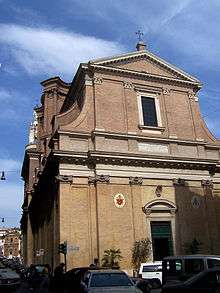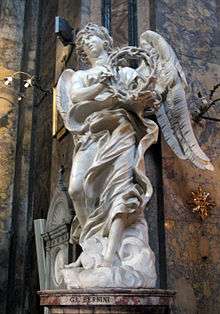Sant'Andrea delle Fratte
| Sant'Andrea delle Fratte | |
|---|---|
 | |
| Basic information | |
| Location |
|
| Geographic coordinates | 41°54′13″N 12°29′01″E / 41.903629°N 12.483552°ECoordinates: 41°54′13″N 12°29′01″E / 41.903629°N 12.483552°E |
| Affiliation | Roman Catholic |
| Website |
santandreadellefratte |
| Architectural description | |
| Architect(s) | Francesco Borromini and Mattia de Rossi |
| Architectural type | Church |
| Architectural style | Baroque |
| Groundbreaking | 1604 |
| Completed | 1826 |
Sant'Andrea delle Fratte is a 17th-century basilica church in Rome, Italy, dedicated to St. Andrew. The Cardinal Priest of the Titulus S. Andreae Apostoli de Hortis is Ennio Antonelli.
History
The current church was built over a pre-existing one, erected in 1192, called infra hortes ("amidst the orchards", whence the name fratte, "woods") for it was located in a countryside area on the northern edge of the inhabited area of medieval Rome. The church originally belonged to Augustinian nuns.[1] It became the national church of the Scottish people in Rome, until Scotland became Protestant, when in 1585 Pope Sixtus V assigned it to the Minim friars of Saint Francis of Paola. The Scots College, the seminary for young men studying for the priesthood, was located nearby, on the Via del Tritone, until 1604, when it moved to the Via del Quattro Fontane.[2]
In 1942 Pope Pius XII elevated the church to a minor basilica.[3]
Fabric of the Church
In 1604 the construction of the new church was begun, to the design of Gaspare Guerra. The project, halted eight years later, was revamped in 1653 by Francesco Borromini, who is responsible of the apse, the tambour of the cupola,[4] and the square campanile with four orders. After his death, the construction was continued by Mattia De Rossi. The late Renaissance-style façade, with two orders divided by pilasters, was completed in 1826, thanks to funds provided the Testament of Cardinal Ercole Consalvi.[5]
Interior
The interior has a single nave. The decoration of the cupola is by Pasquale Marini. Along the nave in the first chapel is a wooden ‘’tempietto’’ (temple) (1674) painted by Borgognone and on the wall is a “Baptism of Christ” of Ludovico Gimignani. In the third chapel is the funeral monument of Cardinal Pierluigi Carafa sculpted by Pietro Bracci.[6] In the cloister, the lunettes are frescoed with stories from the Life of Saint Francesco by Marini, Francesco Cozza, and Filippo Gherardi. In the transept, the altar (1736) was designed by Filippo Barigioni, the altarpiece of Saint Francis of Paola was painted by Paris Nogari, the stuccoed angels were added by Giovanni Battista Maini. The presbytery dome has a fresco of the Multiplication of the loaves and fishes by Marini. Behind the altar, is a Crucifixion of Sant’Andrea by Giovanni Battista Lenardi,[7] the Entombment of Sant’Andrea by Francesco Trevisani, and a Death of Saint Andrew by Lazzaro Baldi.
The altar in the left transept was designed by Luigi Vanvitelli and Giuseppe Valadier with an altarpiece of Saints Anne, Young John the Baptist, and Mary by Giuseppe Bottani.
Bernini's angels
At the sides of the presbytery are two angels (1667-1699) by Bernini, the "Angel with the Crown of Thorns" and the "Angel with the Scroll". They were originally intended for the Ponte Sant'Angelo, but Pope Clement IX considered them too valuable to be exposed to the elements and they were later moved here and replaced on the bridge with copies.[1]
In the third chapel on the left is a Madonna of the Miracle by Domenico Bartolini, to commemorate the place where, on 20 January 1842, the Blessed Virgin Mary appeared to a young Jewish man, Maria Alphonse Ratisbonne, leading him to convert to Catholicism. He later founded the Congregation of Notre-Dame de Sion (Our Lady of Sion), a group of Catholic priests, lay brothers and Religious Sisters dedicated to work for the conversion of Jews to Catholicism. In honor of this apparition, the pews of the church are oriented to this altar.
In 1950 the chapel was completely renovated by the architect Marcello Piacentini and enriched with precious marble.[7]
Burials
- Petar Parchevich, Archbishop of Marcianopolis in Bulgaria (d. 1674)
- Cardinal Carolo Leopoldo Calcagnini (1679-1746)
- Cardinal Pierluigi Carafa (1677-1755)[8]
- Cardinal Ludovico Valenti (1695-1763)
- Felice Giani
- Angelika Kauffmann, Swiss painter (d. 1807)[9]
- Orest Kiprensky, the Russian painter (d. 1836)[10]
Gallery
 Angel with the Crown of Thorns by Bernini
Angel with the Crown of Thorns by Bernini Angel with the Superscription by Bernini
Angel with the Superscription by Bernini
References
- 1 2 "S.Andrea Della Fratte", Roma Segreta, February 6, 2016
- ↑ William James Anderson (1961). History of the Scots College, Rome, 1600-1792. Glasgow: John S. Burns.
- ↑ Parish of St. Andrew Fratte, Diocese of Rome
- ↑ V. Zanchietti, "Il tiburio di Sant'Andrea delle Fratte: propositi e condizionamenti nel testo borrominiano," Annali di archittetura 9 (1997), 112-135.
- ↑ Forcella, p. 238 no. 608.
- ↑ Forcella, p. 233, no. 592.
- 1 2 Monti, Mauro. "Sant'Andrea delle Frate and Our Lady of the Miracle", TV2000
- ↑ Forcella, p. 234 no. 592.
- ↑ Forcella, p. 235, no. 598.
- ↑ Forcella, p. 244, no. 622.
Books
- Forcella, Vincenzo (1876). Iscrizioni delle chiese e d'altri edificii di Roma dal secolo XI fino ai giorni nostri. Volume VIII. Roma: Tip. delle scienze matematiche e fisiche. pp. 213–254.
- Nibby, Antonio (1839). Roma nell'anno MDCCCXXXVIII: pte. I-II. Antica. Roma: Tipografia delle belle arti. pp. 77–80.
- Salvagnini, Francesco Alberto (1967). La Basilica di S. Andrea delle Fratte: santuario della Madonna del Miracolo. Roma: Basilica S. Andrea delle Fratte.
| Wikimedia Commons has media related to Sant'Andrea delle Fratte. |